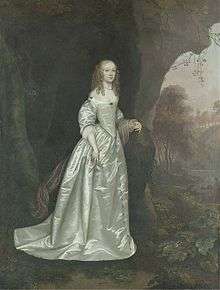Joan Carlile
Joan Carlile or Carlell or Carliell[3] (c. 1606–79),[1] was an English portrait painter. She was one of the first British women known to practise painting professionally.[4][5] Before Carlile, known professional female painters working in Britain were born elsewhere in Europe, principally the low countries.
Joan Carlile | |
|---|---|
 Joan Carlile's Portrait of a lady, possibly Lady Anne Wentworth. Oil on canvas (125 x 101 cm) | |
| Born | Joan Palmer[1] c. 1606 |
| Died | 1679 London[2] |
| Resting place | Churchyard of Petersham Parish Church |
| Nationality | English |
| Known for | Portrait painting |
| Spouse(s) | Lodowick Carlell or Carlile |
Biography
%3B_Sir_Thomas_Browne_by_Joan_Carlile.jpg)
Joan Carlile was born as Joan Palmer, the daughter of William Palmer, an official in the Royal Parks.[6] Carlile copied the works of Italian masters and reproduced them in miniature.[6] She was also an accomplished painter in her own right.
In July 1626[3] she married Lodowick Carlell or Carlile, Gentleman of the Bows to Charles I and a poet and dramatist,[6] who, as keeper/deputy ranger at Richmond Park during the Commonwealth period, had accommodation at Petersham Lodge,[7] which was demolished in the 1690s by Lawrence Hyde, Earl of Rochester.[8] The couple moved to Covent Garden in 1654[4] but returned to Petersham two years later[1] after the restoration of the monarchy, when Lodowick was given the post of "Keeper of the house or Lodge and the Walk at Petersham". They returned to London in 1665.[4]
Lodowick died in 1675 and was buried in the churchyard of Petersham Parish Church (which was then in Surrey and is now in the London Borough of Richmond upon Thames). Joan, who was then living in the parish of St Martin-in-the-Fields,[3] died in 1679, and was buried beside her husband on 27 February.[1][3]
They had two children, James (who was married to Ellen; they had two sons, James and Lodowick) and Penelope (married to John Fisher, a lawyer of the Middle Temple).[3]
Works
Carlile's portrait Lady Dorothy Browne and Sir Thomas Browne is held at London's National Portrait Gallery.[9] The National Portrait Gallery's portrait of Sir Thomas Browne is also attributed to her.
In 2016, the Tate acquired Carlile's Portrait of an Unknown Lady which she painted between 1650 and 1655.[10]
A painting from circa 1648[11] of Elizabeth Murray, Countess of Dysart with her husband and sister has been attributed to Carlile and is held by the National Trust. It is on display at Ham House.[11][12] Another painting of the Countess of Dysart, attributed to Carlile, is held by the Thirlestane Castle Trust.[13]
The Carlile Family with Sir Justinian Isham in Richmond Park is held at Lamport Hall in Lamport, Northamptonshire.[14] Also known as A Stag Hunt,[6] The Stag Hunt,[15] or Stag hunt in Richmond Park,[16] it was exhibited at the Tate Gallery in 1972.[6]
Her full-length portrait of a lady, believed be Lady Anne Wentworth, in a white dress and a purple mantle, is in a private collection.[2]
A miniature portrait, attributed to Carlile, described as A Lady, Wearing White Dress With Brooch At Her Corsage... was auctioned by Sotheby's in London in 2005.[17]
See also
References
- Arianne Burnette (2010). "Joan Carlile". Oxford Dictionary of National Biography. Oxford University Press. Retrieved 3 December 2012.
- "Lot 303: Joan Carlisle (London? c. 1606–1679 Petersham)". Important Old Master Paintings by Christie's. Invaluable. 26 January 2005. Retrieved 22 February 2015.
- Charles H Gray (1905). "Lodowick Carliell; his life, a discussion of his plays, and The deserving favourite, a tragi-comedy reprinted from the original edition of 1629". University of Chicago Press. Retrieved 20 March 2013.
- Margaret Toynbee and Gyles Isham (September 1954). "Joan Carlile (1606?–1679): An Identification". The Burlington Magazine. 96 (618): 275–277. JSTOR 871403.CS1 maint: uses authors parameter (link)
- Phaidon Editors (2019). Great women artists. Phaidon Press. p. 87. ISBN 0714878774.
- Cathy Hartley (2004). A Historical Dictionary of British Women. Taylor & Francis. p. 166. ISBN 978-020340390-7. Retrieved 18 February 2016.
- David McDowall (1996). Richmond Park: The Walker's Historical Guide. p. 47. ISBN 978-0952784708. OCLC 36123245. OL 8477606M.
- "Lost buildings in Richmond Park: the Prime Minister's school and a magnificent mansion". The Collection. The Hearsum Collection. Retrieved 7 September 2015.
- "Lady Dorothy Browne, née Mileham; Sir Thomas Browne". Art UK. Retrieved 28 March 2016.
- "Tate acquires its earliest work by a woman artist" (Press release). London: Tate Gallery. 20 September 2016. Retrieved 1 July 2018.
This new acquisition is the earliest work by a woman artist to enter the collection.
- "Elizabeth Murray, Countess of Dysart (1626–1698), with her First Husband, Sir Lionel Tollemache (1624–1669), and her Sister, Margaret Murray, Lady Maynard (c.1638–1682)". National Trust Collections. National Trust. Retrieved 15 April 2014.
- "Elizabeth Murray (1626–1698), Countess of Dysart, with Her First Husband, Sir Lionel Tollemache (1624–1669), and Her Sister, Margaret Murray (c.1638–1682), Lady Maynard". Art UK. Retrieved 27 March 2016.
- "Elizabeth Murray (c.1630–1698), Countess of Dysart and Duchess of Lauderdale". Art UK. Retrieved 28 March 2016.
- "The Carlile Family with Sir Justinian Isham in Richmond Park". Art UK. Retrieved 28 March 2016.
- Germaine Greer (2001). The Obstacle Race: The Fortunes of Women Painters and Their Work. London and New York: Tauris Parke. pp. 255–256. ISBN 1 86064 677 8.
- "Stag hunt in Richmond Park". The art world in Britain 1660 to 1735. Archived from the original on 3 March 2016. Retrieved 18 February 2016.
- "Some works of Anna Joan Carlile". Arcadja. Retrieved 18 February 2016.